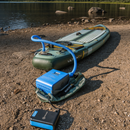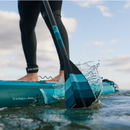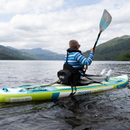Do you need a life jacket on a paddle board? Safety Guide

The Outdoor Foundation has shown the popularity of paddle sports such as kayaking, canoeing, and stand-up paddle boarding with a significant surge, especially during the pandemic. In 2020 alone, the statistics recognized a historic number of 37.9 million enthusiasts joining American waters.
This influx, however, has brought with it a stark rise in accidents, with 331 reported incidents and a disturbing record of 202 fatalities, representing over a quarter of all boating deaths that year. So, do you need a life jacket on a paddle board? Does it really matter? Read on this article to find the answers to this important question.Do You Need a Life Jacket on a Paddle Board?
Paddlers should wear a life jacket approved by USCG and carry the necessary gear for a safe and enjoyable experience. Choosing the right type of life jacket or PFD is essential for safe paddle boarding.
What are the Advantages and Disadvantages of Wearing a Life Jacket?
After getting general ideas about the question “Do you need a life jacket on a paddle board or not?” let’s discuss its advantages and disadvantages for water enthusiasts. Apart from significant benefits for paddle board safety, there are always potential risks if you don’t choose the appropriate types.

Paddle boarders should be responsible for handling these risks with proper preparation. Check out the following advantages and disadvantages of wearing a life jacket (PFD) to help you choose the right type before joining the water:
Pros:
- Help weak swimmers be more confident
- Help you stay above water in an emergency
- Keeps you warmer in and out of the water
- Has extra pockets
- Comes with additional features
- Could save your life
Cons:
- It might feel tight (especially if it's the wrong size or not fitted correctly)
- It can make it harder to climb back on your board (especially when using thicker iSUPs or wearing a bulky PFD)
- There is a risk of getting too hot when paddling in warmer climates
What are Life Jacket Requirements for Stand Up Paddling?
So what are paddle board life jacket requirements? For individuals engaging in stand-up paddling (SUP) outside of designated surfing, swimming, or bathing areas, the U.S. Coast Guard (USCG) has set specific requirements for life jackets to ensure safety on the water. According to this organization’s regulations, every paddler aged 13 and over must have a USCG-approved life jacket available.
This life jacket can be of Type I, II, III, or an appropriate Type V. Though it's not mandatory for those over 13 to wear it at all times, it is highly recommended for safety. However, children under the age of 12 must wear their life jackets at all times.

Type V life jackets are only permissible for those 16 and older and must be worn at all times on the water. Additionally, to comply with USCG regulations, the life jacket must be in good condition, properly sized, and appropriately fitted to the wearer.
This mandate proves the importance of preparedness and the prioritization of safety in paddle sports. It showcases a comprehensive approach to ensuring that paddling enthusiasts can enjoy their activity while minimizing risks on open waters.
What Types of Life Jacket for Stand Up Paddle Boarding?

- Type I life jackets: The best option for rough water conditions and remote waterways. They provide excellent buoyancy with functional designs to turn an unconscious wearer face up in the water. However, they are quite bulky.
- Type II life jackets: Well-suited for near-shore activities. While less bulky than Type I, they still offer good buoyancy. However, they may not keep an unconscious person's head out of water.
- Type II inflatable life jackets: These can be used by adults for near-shore activities but require manual inflation. Children under 16 or non-swimmers should not wear this type of PFD.
- Type III life jackets: They strike a balance between buoyancy and comfort, a preferred choice for paddle boarding and various water sports. However, they will not turn an unconscious wearer face up.
- Type III inflatable life jackets: Appropriate for calm waters but require manual inflation to work.
- Type V life jackets: Designed for specific activities and must be worn at all times to comply with Coast Guard regulations.
How Can You Choose The Right Type of Life Jacket?
Now that you know the popular options for stand up paddle boarding, it’s time to think about what suits you.

People who do stand up paddle boarding come in different shapes and sizes and have different skill levels, interests, comfort, and experience on the water. We should choose a PFD based on some of these considerations.
- Comfortable size: Ensure the PFD fits well, neither too tight nor too loose. Visit an outfitter for precise sizing or take accurate body measurements at home. Consider the bulk of clothing you'll wear while SUPing.
- Suitable style: Manufacturers offer a variety of design elements. Are life vests required on paddle boards? Yes, you can decide whether you prefer a traditional vest, an inflatable life belt, or another style.
- Paddling experience: Assess your comfort and experience level on the water. Novice paddlers might prefer more buoyant, visible options.
- Things to wear under your PDF: Your usual SUP attire, which could range from a swimsuit to a wetsuit, depending on the weather. You should choose comfortable and non-restrictive clothing to allow for a full range of motion with a paddle board.
- Cost: Choose one that suits your budget, but remember that quality and safety should not be compromised. Consider reputable brands known for their durability and safety features.
What are Standard Life Jacket Size?
It's important to understand the different options available when it comes to standard life jacket sizes. To help with this, we have provided a detailed table displaying the information for standard life jacket sizes for adults and kids.
Standard Life Jacket Sizes for Adults Display information with table
You can refer to this table to learn the exact standard life jacket for adults.
| Size | Chest Size (inches) |
|---|---|
| Extra Small | 28-32 |
| Small | 23-36 |
| Medium | 36-40 |
| Large | 40-44 |
| X-Large | 44-48 |
| XX-Large | 48-52 |
| XXX-Large | 52-56 |
Standard Life Jacket Sizes for Kids Display information with table
To answer the question "Are life jackets required on paddle boards in California?" the following table displays standard life jacket sizes for kids based on weight.
| Size | Weight Range (lbs) |
|---|---|
| Infant PFD | 8-30 |
| Child PFD | 30-50 |
| Youth PFD | 50-90 |
Other Accessories You Need for Paddle Boarding
We have answered the question: “Are life jackets required for paddle boards?”. Besides understanding that, remember the following items and accessories for your paddle board. Whether you plan to go on a long day trip, camp overnight, or venture into open water, these items can be useful. Make sure to have these essentials with you if you need to bring a lot of gear.

- Towline
- Deck bags or dry bags
- Camera mount
- GPS
- Two-way radios
- Weather/VHF radio
- Guidebook
- Maps and charts in a waterproof case
- Compass (that floats)
- Knife
- Fishing gear
- SUP carry strap
- SUP transport cart
Enjoy Safety Paddle Boarding with iROCKER
Maybe you are now getting the general ideas about the “Do you need a life jacket on a paddle board?” issue. Now, get ready for a safe and enjoyable paddle boarding experience with iROCKER!

Our inflatable SUPs have been rigorously tested and approved by beginners, intermediate paddlers, and families with thousands of rave reviews from around the world. Since our launch in 2013, our mission has been to provide reliable and fun gear so you can trust what's beneath your feet. With a focus on top-quality manufacturing, design, and functionality, we have everything you need for your paddle-boarding adventure.
FAQs
Do you need both a leash & a life jacket?
Both offer different protection and are essential. Invest in a leash and a US Coast Guard-approved PFD when buying a paddle board. These tools can save the lives of people who use stand-up paddle boards.
How to help children wear a life jacket?
To help children wear a life jacket, it's best to make them familiar with it before the activity. This will help them feel more comfortable and less likely to panic. Babies and toddlers may not like wearing a life jacket at first, so it's a good idea to prepare them at home if possible. You can offer a reward for keeping it on to make them feel more enjoyable.
How to fit a PFD correctly?
It's important to choose the right size PFD based on chest measurement and weight. Once you've selected the correct size, it's crucial to adjust it properly to ensure it works as intended and can help save your life. Here's how to fit a PFD using Palm's suggested method:
-
Loosen all the straps and buckles.
-
Put on the PFD and fasten any buckles without tightening the chest harness yet (if fitted).
-
Tighten all straps, starting from the waist and working upwards to the shoulder straps.
-
Lastly, tighten and fasten the chest harness. Sit down and check the shoulder straps to finish.
Reference
Water Sports Foundation. (2022, April 12). As Record Numbers of Paddlers Take to The Water, Accidents Surge. Retrieved from https://www.watersportsfoundation.com/as-record-numbers-of-paddlers-take-to-the-water-accidents-surge/






